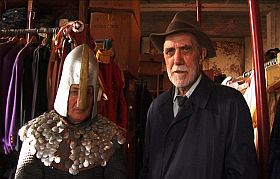Jeg ved godt, at jeg burde kunne lide den film. Hele den meget omfattende foromtale lægger op til det. Men jeg kan faktisk ikke lide den, eller rettere, kunne ikke lide den i begyndelsen, var gået til den præget af al for meget fremmed viden, som havde stemt mig negativ. Negativ fra begyndelsen. Så jeg kiggede overbærende på billederne af et boligkvarters kølige orden, de rene gader, de ordentlige hække. Inde var der velafrettede beboere i yderst velholdte trapperum og der var nøgler og låse i en uendelig kadence, forekom det. Så var der med ét en lang scene med tre herrers samtale om deres medborgere fra Tyrkiet. Det var direkte ubehageligt. Min arrogante overbærenhed var ved at fordampe, filmen bgyndte at virke på sine egne betingelser, jeg glemte mere og mere af, hvad jeg havde læst, også instruktørens egen synopsis. Hans film tog selv magten. Den film tager magten.
Jeg er herefter i kældrene. Der er folk på løbebånd, i svømmebassin, i romaskine. Fornuftigt nok. Så er der kvinder stående alvorlige, som hos Peter Greenaway og hos Roy Andersson, i deres fine vaskerum i kælderen ved siden af deres vaskemaskiner som de på en måde ligner. Nå sådan, tænker jeg. Men herefter begynder chokkene. En kvinde med badekåbe over natkjolen og sokker på fødderne i tøflerne går roligt, trin for trin, fra repos til repos ned ad denne rengjorte trappe og hen ad en gang med ordentlige døre til perfekte pulterrum. Hun låser sig ind, jeg tror hun låser efter sig, hun tager en æske ned af en hylde, tager låget af og silkepapiret til side og tager en livagtig babydukke op og kærtegner den hengiven. Den er som levende, den er hendes liv. Den lægges ned igen, puttes. Silkepair og låget lægges på. Denne scene gentages. Det må være flere gange om dagen. Munterheden jeg havde forventet har filmen metodisk ændret til en sørgmodig stemning, og fra dette sted ser jeg filmen med voksende sorg.
Jeg ser på og hører på og bliver bedrøvet ved en omvisning i et kældermuseum af jagttrofæer, jeg lytter til hornmusik, som især blæserne holder af, og til operasang, ikke i badeværelset, men i kælderen med en endnu mere imødekommende akustik, fordi væggene er nøgne. Rummet er en skydebane, hvor sangeren, som også instruerer i selvforsvar ved pistolskydning, øver sig i begge kunstarter. Tilsvarende sagligt skildrer filmen, jeg mener det er herefter, i lige så omhyggeligt byggede, stiliserede scener en række generøst medvirkendes seksuelle udfoldelser i pinagtigt lange og teknisk detaljerede scener.
Inde i dette mest private føler jeg mig aldels utilpas, skønt jeg er inviteret og formodentlig velkommen. Jeg savner distancen, som hos Greenaway for eksempel den overdådige scenografis skønhed, som hos Andersson den afvæbnende humors glæde, og jeg stiller mig spørgsmålet, hvorvidt der i denne teknisk perfekte film, i det fremragende kameraarbejde for eksempel, er skønhed nok til at distancere denne overskridelse af min norm for, hvad jeg egentlig gerne vil se? Er disse scener egentlig smukke?
Og længe efter jeg har set den, afviser jeg faktisk filmen, holder dens scener, dens billeder og handling og dialog ude fra mig i strakt arm næsten, så jeg ikke mærker lugten. Men så kommer jeg til at tænke på kvinden, som står der nøgen bundet sindrigt i reb og knuder som en af Nobuyoshi Arakis modeller. Den kvinde i den scene kan jeg ikke afvise. Det er ikke hendes fortælling i og for sig, nej, det er heller ikke det hele. Den scene fæstner sig. Jeg tror det er en særlig sødme i hendes attityde, en åbenlys uskyld i hendes valg af ydmygelse og tvang og smerte. Og så er det jeg tænker, at i denne uskyldens belysning burde jeg se filmen igen.
Det er jo alt sammen måske at gemme lykken og friheden af vejen. I kælderen. Gemme den for ægtefællen, for naboerne, for de andre, kun ikke for de medsammensvorne, har man sådanne. De andre ser stueetagen, 1. sal. Der hersker konventionen, som gør de andre trygge, der er den pæne stue, den rene, vedtagne skønhed etableret. I kælderen findes den ægte glæde og nydelse i afvigende skønhed. I kælderen findes sandheden så nær, at den den næsten kan nås. Det kan være, det er det Ulrich Seidl vil vise med sit arbejde, vemodig og mærket af smerte. Hans scener er serier af hellige handlinger, hvor smertens lyst er højdens punkt.
SYNOPSIS / QUOTATION
SYNOPSIS / QUOTATION
The film is about people and basements and what people do in their basements in their free time. The film is about obsessions. The film is about brass-band music and opera arias, about expensive furniture and cheap male jokes, about sexuality and shooting, fitness and fascism, whips and dolls.
After his ambitious Paradise Trilogy, Ulrich Seidl returns to the documentary form with “In the Basement.” A film essay that is both funny and sad, it uses the director’s characteristic film tableaux to delve into the underground of the Austrian soul. (Ulrich Seidl Film Production)
DIRECTORS STATEMENT
The basement in Austria is a place of free time and the private sphere. Many Austrians spend more time in the basement of their home than in their living room, which often is only for show. In the basement they actually indulge their needs, their hobbies, passions and obsessions. But in our unconscious, the basement is also a place of darkness, a place of fear, a place of human abysses. (Ulrich Seidl)
Østrig 2014, 85 min. Vises af DOXBIO 8. april i mange biografer.
Liste over premierebiografer: http://www.doxbio.dk/?page_id=2040
Facebook: www.facebook.dk/dokumentar
Trailer: http://www.doxbio.dk/?movie-archive=kaelderen-8-april



